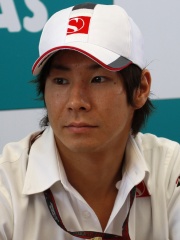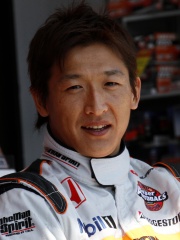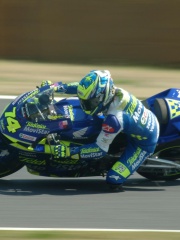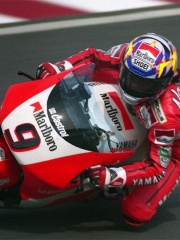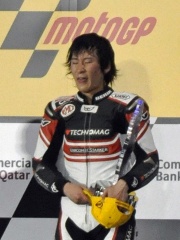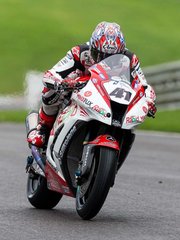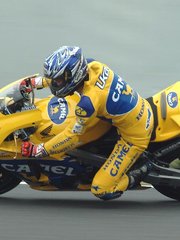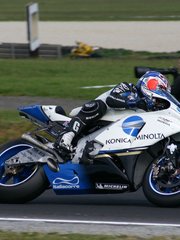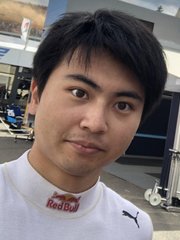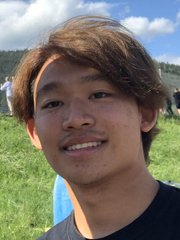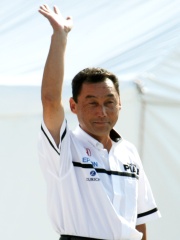
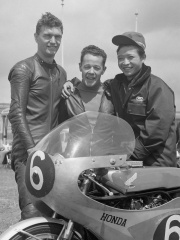
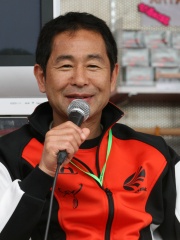
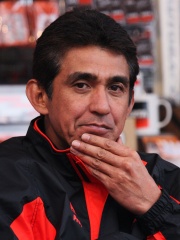
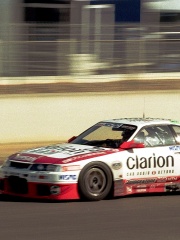
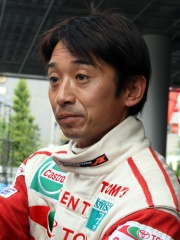
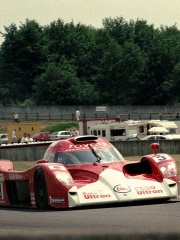

The Most Famous
RACING DRIVERS from Japan
This page contains a list of the greatest Japanese Racing Drivers. The pantheon dataset contains 1,080 Racing Drivers, 37 of which were born in Japan. This makes Japan the birth place of the 7th most number of Racing Drivers behind Germany, and Spain.
Top 10
The following people are considered by Pantheon to be the top 10 most legendary Japanese Racing Drivers of all time. This list of famous Japanese Racing Drivers is sorted by HPI (Historical Popularity Index), a metric that aggregates information on a biography's online popularity. Visit the rankings page to view the entire list of Japanese Racing Drivers.

1. Satoru Nakajima (b. 1953)
With an HPI of 61.95, Satoru Nakajima is the most famous Japanese Racing Driver. His biography has been translated into 29 different languages on wikipedia.
Satoru Nakajima (Japanese: 中嶋 悟, Hepburn: Nakajima Satoru; born 23 February 1953) is a Japanese former racing driver and motorsport executive, who competed in Formula One from 1987 to 1991. Born and raised in Okazaki, Aichi, Nakajima began his racing career at the Suzuka Circuit in 1973. He progressed to Japanese Formula Two in 1977, winning a then-record five titles between 1981 and 1986, with 21 victories across 10 seasons. After several appearances in sportscar racing via the World Sportscar Championship and the All Japan Endurance Championship—as well as a season in International Formula 3000—Nakajima signed for Lotus in 1987 to partner Ayrton Senna, becoming the first Japanese driver to compete full-time in Formula One at the Brazilian Grand Prix. He scored his maiden points finish at the following round in San Marino, and achieved a career-best fourth place at the British Grand Prix. Across his remaining two seasons at Lotus, Nakajima scored points finishes at the 1988 Brazilian and 1989 Australian Grands Prix, setting the fastest lap and finishing fourth at the latter. Nakajima moved to Tyrrell in 1990, scoring points finishes in the United States, Italy and his home Grand Prix in Japan. Retaining his seat for his 1991 campaign at Tyrrell under Honda power, Nakajima scored his final points at the season-opening United States Grand Prix, leaving at the end of the season to join Honda's works team project. Nakajima tested the RC100 and related models until 1994, when Honda pulled out of Formula One following the Japanese asset price bubble. Upon retiring from motor racing, Nakajima focused on his Nakajima Racing team, which he had founded in 1984 to privately enter March chassis into the Japanese Formula Two Championship, winning three consecutive titles until 1986. Nakajima won four Formula Nippon Teams' Championship titles between 1999 and 2009, still competing in the newly-formed Super Formula Championship, as well as the Super GT Series. Nakajima's sons Kazuki and Daisuke both became racing drivers, the former also competing in Formula One for Williams from 2007 to 2009.

2. Kunimitsu Takahashi (1940 - 2022)
With an HPI of 60.37, Kunimitsu Takahashi is the 2nd most famous Japanese Racing Driver. His biography has been translated into 24 different languages.
Kunimitsu Takahashi (Shinjitai: 高橋 国光, Takahashi Kunimitsu; 29 January 1940 – 16 March 2022) was a Japanese professional motorcycle road racer, racing driver, and team manager. Nicknamed "Kuni-san", he is known as the "father of drifting". Takahashi's racing career lasted from 1958 to 1999. He competed on motorcycles between 1958 and 1963, during which he became the first Japanese rider to win a World Grand Prix, taking four world-level wins in total. Injuries sustained in a crash in 1962 led to him switching to four-wheels in 1965, after which he won the 24 Hours of Le Mans in class, become a four-time All-Japan Sports Prototype Champion, and won in Japanese Top Formula, JTC, and JGTC. His final victory as a driver came in 1999 at the age of 59. Takahashi's racing team, Team Kunimitsu, has won multiple championships in Super GT. He was the chairman of the GT Association, the organizers of the Super GT series, from 1993 to 2007.

3. Keiichi Tsuchiya (b. 1956)
With an HPI of 59.50, Keiichi Tsuchiya is the 3rd most famous Japanese Racing Driver. His biography has been translated into 16 different languages.
Keiichi Tsuchiya (土屋圭市, Tsuchiya Keiichi; born January 30, 1956) is a Japanese professional race car driver. He is known as the Drift King (ドリキン, Dorikin) for his nontraditional use of drifting in non-drifting racing events and his role in popularizing drifting as a motorsport. In professional racing, he is a two-time 24 Hours of Le Mans class winner and the 2001 All Japan GT Championship runner-up. He is also known for tōge driving. The car he drives, a Toyota AE86 Sprinter Trueno, has become one of the most popular sports cars; the car is also known as "Hachi-Roku" in Japan (hachi-roku meaning "eight-six"); his car is also called "The Little Hachi that could." A 2-part video known as 'The Touge' produced by Pluspy (styled as +P) documents Tsuchiya's touge driving with his AE86. He was a consultant for the popular manga and anime series, Initial D, in which he makes several cameos. He also served as a stunt coordinator and stuntman on The Fast and the Furious: Tokyo Drift, where he also made a cameo appearance.

4. Aguri Suzuki (b. 1960)
With an HPI of 57.67, Aguri Suzuki is the 4th most famous Japanese Racing Driver. His biography has been translated into 25 different languages.
Aguri Suzuki (Japanese: 鈴木 亜久里, Hepburn: Suzuki Aguri; born 8 September 1960) is a Japanese former racing driver and motorsport executive, who competed in Formula One from 1988 to 1995. Suzuki entered 88 Formula One Grands Prix, achieving a best result of third at the 1990 Japanese Grand Prix, becoming the first Asian driver to score a podium finish. He also won the Japanese Formula 3000 Championship in 1988, and later finished third overall at the 24 Hours of Le Mans in 1998. He was also a race-winner in the All-Japan GT Championship. Suzuki became involved in team ownership after his Formula One career, first forming Autobacs Racing Team Aguri (ARTA) in 1997 in partnership with Autobacs. ARTA has competed mostly in Super GT, where they have won titles in both the GT500 and GT300 classes. He was the owner of the Super Aguri F1 team, which participated in Formula One from 2006 to 2008. He also formed Team Aguri, which raced in Formula E from 2014 to 2016.
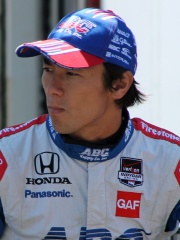
5. Takuma Sato (b. 1977)
With an HPI of 57.26, Takuma Sato is the 5th most famous Japanese Racing Driver. His biography has been translated into 45 different languages.
Takuma "Taku" Sato (Japanese: 佐藤 琢磨, Hepburn: Satō Takuma; born 28 January 1977) is a Japanese racing driver, who competes part-time in the IndyCar Series for Rahal Letterman Lanigan Racing. Sato competed in Formula One from 2002 to 2008. In American open-wheel racing, Sato is a two-time winner of the Indianapolis 500 in 2017 and 2020, remaining the only Asian driver to win the event. Born and raised in Tokyo, Sato began his career in karting before moving to Europe in 1999 with support from Honda. Progressing directly to Formula Three, Sato finished third in the British Championship in 2000 before dominating the series in 2001 with Carlin. During the latter, he also won the Macau Grand Prix and the Masters of Formula 3. Sato signed for Jordan in 2002, making his Formula One debut at the Australian Grand Prix, under Honda power. He moved with Honda to join BAR in 2003 as a reserve driver, replacing Jacques Villeneuve at his home Grand Prix in Japan and returning as a full-time driver in 2004. Sato achieved his only podium finish at the United States Grand Prix as he finished a career-best eighth in the World Drivers' Championship. Following struggles at BAR in 2005, Sato moved to Super Aguri for his 2006 campaign onwards. Amidst financial troubles, Super Aguri withdrew from the sport after the 2008 Spanish Grand Prix, ending both Sato and teammate Anthony Davidson's driving careers in Formula One. After a year hiatus, Sato returned to open-wheel racing in the IndyCar Series with KV in 2010. He took his maiden pole position at the Iowa Corn Indy 250 in 2011, and became the first Asian driver to win an IndyCar race at the Grand Prix of Long Beach in 2013 with Foyt. His one-off entry in Formula E at the 2014 Beijing ePrix marked the first—and to this date, only—time that Sato competed without a Honda power unit in his professional career, using a spec McLaren powertrain. Sato signed for Andretti in 2017, winning the Indianapolis 500 for the first time. He took several further wins across his 2018 and 2019 seasons with RLL, before again winning at Indianapolis in 2020. Sato competed for Dale Coyne Racing in 2022, before moving into part-time roles from 2023 onwards. Sato is a widely popular figure amongst fans and media worldwide, renowned for his aggressive driving style and motto No Attack, No Chance.

6. Masahiro Hasemi (b. 1945)
With an HPI of 55.59, Masahiro Hasemi is the 6th most famous Japanese Racing Driver. His biography has been translated into 18 different languages.
Masahiro Hasemi (Shinjitai: 長谷見 昌弘, Hasemi Masahiro; born 13 November 1945) is a former racing driver and team owner from Japan. He started racing motocross when he was 15 years old. In 1964 he signed to drive for Nissan. After establishing himself in saloon car and GT races in Japan, he participated in his only Formula One race at the 1976 Japanese Grand Prix for Kojima on 24 October 1976. He qualified tenth after an error which cost him his chance of a pole position and finished 11th, seven laps behind the winner. Contrary to a widely propagated but mistaken result, however, he never set a fastest lap in a Formula One championship race.1 Along with compatriots Noritake Takahara and Kazuyoshi Hoshino, he was the first Japanese driver to start a Formula One Grand Prix. Hasemi became the Japanese Formula 2 champion in 1980, and got two titles in the Fuji Grand Champion Series in 1974 and 1980. After that he reverted to racing Skylines, which he became heavily synonymous with in Group 5, touring cars and JGTC. He won the Japanese Touring Car Championship in 1989, 1991 and 1992. He also won the All Japan Sports Prototype Championship in 1990, with the controversial win at the Guia Touring Car race at the Macau Grand Prix in 1990 and Daytona 24 hour in 1992. Hasemi retired from driving in 2001 and now runs NDDP Racing, a Super GT team that currently competes in the GT500 class. Hasemi also owns Hasemi Sport, a former Super GT racing team that ran under the Hasemi Motorsport banner and Nissan aftermarket parts company. Hasemi is the most recent Japanese driver to win his home Grand Prix, winning it in 1975, when it was a non-championship race.

7. Ukyo Katayama (b. 1963)
With an HPI of 55.56, Ukyo Katayama is the 7th most famous Japanese Racing Driver. His biography has been translated into 31 different languages.
Ukyo Katayama (Japanese: 片山 右京, Hepburn: Katayama Ukyō; born 29 May 1963) is a Japanese former racing driver and motorsport executive, who competed in Formula One from 1992 to 1997. Katayama participated in 97 Grands Prix, debuting at the 1992 South African Grand Prix, making him the sport's second most experienced Japanese driver. He scored a total of five championship points, all of them for the Tyrrell team in 1994. Katayama also competed in the 1999 24 Hours of Le Mans, finishing second overall and leading the GTP class. He has managed the Japanese continental cycling team Team UKYO since 2012.

8. Toshio Suzuki (b. 1955)
With an HPI of 55.20, Toshio Suzuki is the 8th most famous Japanese Racing Driver. His biography has been translated into 23 different languages.
Toshio Suzuki (鈴木 利男, Suzuki Toshio; born 10 March 1955) is a former racing driver from Saitama Prefecture, Japan.

9. Kazuyoshi Hoshino (b. 1947)
With an HPI of 54.96, Kazuyoshi Hoshino is the 9th most famous Japanese Racing Driver. His biography has been translated into 19 different languages.
Kazuyoshi Hoshino (Shinjitai: 星野 一義, Hoshino Kazuyoshi; born 1 July 1947) is a Japanese former racing driver and businessman.

10. Hiroshi Fushida (b. 1946)
With an HPI of 54.81, Hiroshi Fushida is the 10th most famous Japanese Racing Driver. His biography has been translated into 21 different languages.
Hiroshi Fushida (鮒子田 寛; , born 10 March 1946) is a Japanese former racing driver. He is the first Japanese driver to enter a Formula One World Championship Grand Prix, and the first to compete in the 24 Hours of Le Mans endurance race.
People
Pantheon has 37 people classified as Japanese racing drivers born between 1940 and 2001. Of these 37, 33 (89.19%) of them are still alive today. The most famous living Japanese racing drivers include Satoru Nakajima, Keiichi Tsuchiya, and Aguri Suzuki. The most famous deceased Japanese racing drivers include Kunimitsu Takahashi, Daijiro Kato, and Norifumi Abe. As of April 2024, 6 new Japanese racing drivers have been added to Pantheon including Noriyuki Haga, Hiroshi Masuoka, and Tohru Ukawa.
Living Japanese Racing Drivers
Go to all RankingsSatoru Nakajima
1953 - Present
HPI: 61.95
Keiichi Tsuchiya
1956 - Present
HPI: 59.50
Aguri Suzuki
1960 - Present
HPI: 57.67
Takuma Sato
1977 - Present
HPI: 57.26
Masahiro Hasemi
1945 - Present
HPI: 55.59
Ukyo Katayama
1963 - Present
HPI: 55.56
Toshio Suzuki
1955 - Present
HPI: 55.20
Kazuyoshi Hoshino
1947 - Present
HPI: 54.96
Hiroshi Fushida
1946 - Present
HPI: 54.81
Kamui Kobayashi
1986 - Present
HPI: 54.02
Noritake Takahara
1951 - Present
HPI: 53.67
Yuji Ide
1975 - Present
HPI: 53.46
Deceased Japanese Racing Drivers
Go to all RankingsKunimitsu Takahashi
1940 - 2022
HPI: 60.37
Daijiro Kato
1976 - 2003
HPI: 53.03
Norifumi Abe
1975 - 2007
HPI: 51.49
Shoya Tomizawa
1990 - 2010
HPI: 47.02
Newly Added Japanese Racing Drivers (2025)
Go to all RankingsNoriyuki Haga
1975 - Present
HPI: 47.52
Hiroshi Masuoka
1960 - Present
HPI: 46.73
Tohru Ukawa
1973 - Present
HPI: 46.29
Makoto Tamada
1976 - Present
HPI: 43.86
Ayumu Iwasa
2001 - Present
HPI: 39.45
Marino Sato
1999 - Present
HPI: 35.46
Overlapping Lives
Which Racing Drivers were alive at the same time? This visualization shows the lifespans of the 3 most globally memorable Racing Drivers since 1700.

